
NGC 188 is an open cluster in the constellation Cepheus. It was discovered by John Herschel in 1825. Unlike most open clusters that drift apart after a few million years because of the gravitational interaction of our Milky Way galaxy, NGC 188 lies far above the plane of the galaxy and is one of the most ancient of open clusters known, at approximately 6.8 billion years old.

NGC 3603 is a nebula situated in the Carina–Sagittarius Arm of the Milky Way around 20,000 light-years away from the Solar System. It is a massive H II region containing a very compact open cluster HD 97950.
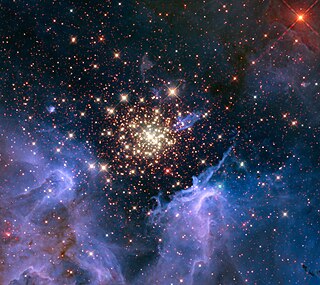
Sher 25 is a blue supergiant star in the constellation Carina, located approximately 25,000 light years from the Sun in the H II region NGC 3603 of the Milky Way. It is a spectral type B1Iab star with an apparent magnitude of 12.2. Its initial main sequence mass is calculated at 60 times the mass of the Sun, but a star of this type will have already lost a substantial fraction of that mass. It is unclear whether Sher 25 has been through a red supergiant phase or has just evolved from the main sequence, so the current mass is very uncertain.

NGC 6357 is a diffuse nebula near NGC 6334 in the constellation Scorpius. The nebula contains many proto-stars shielded by dark discs of gas, and young stars wrapped in expanding "cocoons" or expanding gases surrounding these small stars. It is also known as the Lobster Nebula. This nebula was given the name War and Peace Nebula by the Midcourse Space Experiment scientists because of its appearance, which, in infrared images the bright, western part resembles a dove, while the eastern part looks like a skull. A petition by anime fans to rename it as the Madokami nebula, due to resemblance with a character, was unsuccessful.

NGC 290 is an open cluster of stars in the southern constellation of Tucana. This cluster was discovered September 5, 1826, by Scottish astronomer James Dunlop. It lies some 200,000 light years away from the Sun in the Small Magellanic Cloud galaxy. The cluster is an estimated 30–63 million years old and is around 65 light years across.

NGC 265 is an open cluster of stars in the southern constellation of Tucana. It is located in the Small Magellanic Cloud, a nearby dwarf galaxy. The cluster was discovered by English astronomer John Herschel on April 11, 1834. J. L. E. Dreyer described it as, "faint, pretty small, round", and added it as the 265th entry in his New General Catalogue.
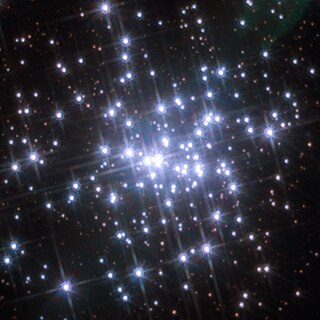
NGC 3603-A1 is a double-eclipsing binary star system located at the centre of the HD 97950 cluster in the NGC 3603 star-forming region, about 25,000 light years from Earth. Both stars are of spectral type WN6h and among the most luminous and most massive known.

HD 97950, is a multiple star system and part of a super star cluster within the NGC 3603 H II region. It was catalogued as a single star although it was always known to be a compact cluster. It is now resolved into a massive multiple star at the centre of one of the densest clusters in the galaxy.
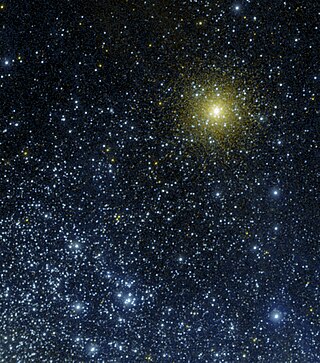
NGC 362 is a globular cluster located in the constellation Tucana in the Southern Hemisphere, slightly north of the Small Magellanic Cloud, to which it is completely unrelated. It was discovered on August 1, 1826 by James Dunlop. It is visible to the naked eye in dark skies, and is an impressive sight in a telescope, although it is somewhat overshadowed by its larger and brighter neighbour 47 Tucanae.

NGC 6604 is a young open cluster of stars in the equatorial constellation of Serpens, positioned about 1.5° north of the Eagle Nebula. The cluster was discovered by William Herschel on July 15, 1784. It is located at a distance of 4,580 light years from the Sun, about 210 ly (65 pc) above the galactic plane. NGC 6604 forms the densest part of the Ser OB2 association of co-moving stars.
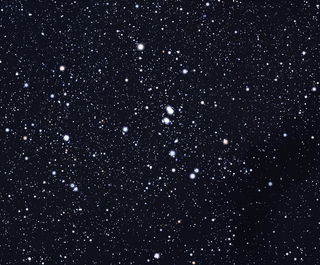
NGC 6871 is a small, young open cluster in the constellation of Cygnus. The cluster has fewer than 50 members, most of which are blue and white stars. It is located 5135 light-years from Earth.

NGC 3603-B is a Wolf-Rayet star located at the centre of the HD 97950 cluster in the NGC 3603 star-forming region, about 25,000 light years from Earth. It has the spectral type WN6h and is among the most luminous and most massive stars known.

NGC 3603-C is a single-lined spectroscopic binary star system located at the centre of the HD 97950 cluster in the NGC 3603 star-forming region, about 25,000 light years from Earth. The primary has spectral type WN6h and is among the most luminous and most massive known.

NGC 146 is a small open cluster in the constellation Cassiopeia. It was discovered by John Herschel in 1829 using his father's 18.7 inch reflecting telescope.

NGC 330 is an open cluster in the Small Magellanic Cloud. It is located in the constellation Tucana. It was discovered on 1 August 1826 by James Dunlop. It was described by Dreyer as "a globular cluster, very bright, small, a little extended, stars from 13th to 15th magnitude." At an aperture of 31.0 arcseconds, the apparent V-band magnitude is 9.60, but at this wavelength, it also has 0.36 magnitudes of interstellar extinction.
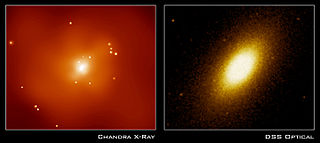
NGC 720 is an elliptical galaxy located in the constellation Cetus. It is located at a distance of circa 80 million light years from Earth, which, given its apparent dimensions, means that NGC 720 is about 110,000 light years across. It was discovered by William Herschel on October 3, 1785. The galaxy is included in the Herschel 400 Catalogue. It lies about three and a half degrees south and slightly east from zeta Ceti.

NGC 4061 is an elliptical galaxy located 310 light-years away in the constellation Coma Berenices. It was discovered by astronomer William Herschel on April 27, 1785. It was rediscovered by John Herschel on April 29, 1832. It is listed both as NGC 4061 and NGC 4055. NGC 4061 is a member of the NGC 4065 Group and forms an interacting pair with its companion, NGC 4065 as evidenced by distortions in their optical isophotes.

NGC 4278 is an elliptical galaxy located in the constellation Coma Berenices. It is located at a distance of circa 55 million light years from Earth, which, given its apparent dimensions, means that NGC 4278 is about 65,000 light years across. It was discovered by William Herschel on March 13, 1785. NGC 4278 is part of the Herschel 400 Catalogue and can be found about one and 3/4 of a degree northwest of Gamma Comae Berenices even with a small telescope.

NGC 4065 is an elliptical galaxy located 300 million light-years away in the constellation Coma Berenices. The galaxy was discovered by astronomer William Herschel on April 27, 1785. It was then rediscovered by John Herschel on April 29, 1832 and was listed as NGC 4057. NGC 4065 is the brightest member of the NGC 4065 Group.
















